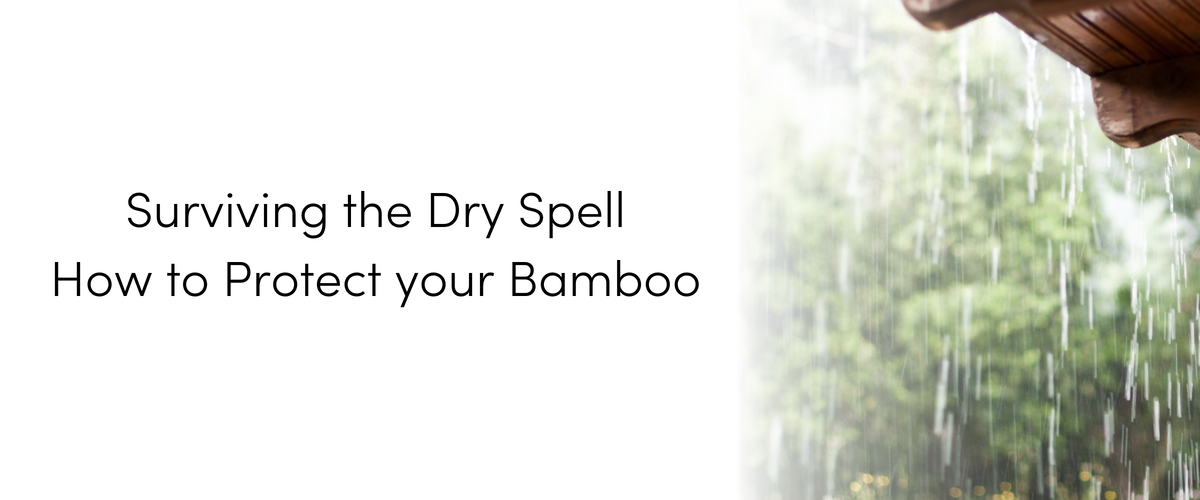Surviving the Dry Spell - How to Protect your Bamboo
El Nino or not, prolonged dry spells with reduced rainfall are bound to occur so you’ll want to be prepared.
Is bamboo drought tolerant?
To keep bamboo plants healthy during prolonged drought periods, you can take the following steps:
Deep cycle watering: Not the status quo - yes, and frequent watering is better in general when water supply is plentiful. However, watering deeply and infrequently rather than shallow, frequent watering will encourage the bamboo's roots to grow deeper and spread out, which will create a more drought-resistant plant. You can use the leaf and culm condition as a visual marker to time your watering, particularly during periods of water restrictions. You need to monitor your plants continuously for this strategy to work. Keep an eye out for signs of drought stress, such as crisp, yellowing leaves, and respond promptly with appropriate watering.
Choose the Right Location: Plant bamboo in a location with well-draining soil to prevent waterlogging during sudden downpours or the sparse (heavy) rains, which may occur, and to ensure the plant can access water when needed.
Pruning: Prune your bamboo to remove dead or unhealthy growth. This allows the plant to focus its resources on maintaining healthy shoots during dry periods. This is also good in the longer term as your plant will look better for it!
Fertilisation: Use a balanced, slow-release fertiliser to promote overall plant health, but avoid over-fertilizing, as this can stress the bamboo during drought.
Shade and Windbreaks: Provide some shade or windbreaks to reduce evaporation and protect bamboo from drying winds.
Monitoring: Regularly check the soil moisture level by sticking your finger into the soil. Water when the top 2-3 inches of soil feel dry.
Mulching: Apply a thick layer of mulch around the base of the bamboo to retain soil moisture, regulate temperature, and suppress weeds that compete for water. This relatively cheap and aesthetically pleasing compliment to your garden should be a vital part of your drought mitigation plan. See our range of mulch offerings here. There are various types of mulch:
- Blackwood Mulch: Blackwood mulch is made from shredded or chipped blackwood trees or similar hardwoods. It has a rich dark color and provides a natural, earthy look to garden beds. It helps retain soil moisture, suppress weeds, and regulate soil temperature.
- Cypress Mulch: Cypress mulch is derived from cypress trees and is known for its durability and resistance to decay and insects. It has a natural golden or light brown color and is often used in landscaping. Cypress mulch offers excellent moisture retention and weed control properties.
- Pine Bark Mulch: Pine bark mulch is crafted from pine tree bark and has a dark brown to reddish-brown color. It's valued for its attractive appearance and ability to regulate soil temperature, suppress weeds, and conserve moisture. Pine bark mulch can vary in texture, with fine and coarse options available.
- Outback Mulch: Outback mulch is a term that may refer to various types of mulch typically found in arid or desert regions. It can include materials like wood chips, straw, or even rocks. Outback mulch serves to conserve moisture, insulate the soil, and reduce erosion in dry environments.
- Straw Mulch: Straw mulch consists of chopped or shredded straw from grains like wheat or barley. It is light in color and is often used for vegetable gardens and around newly seeded areas. Straw mulch helps prevent soil erosion, retain moisture, and keep weeds at bay.
Each type of mulch has its own unique characteristics and aesthetic appeal. The choice of mulch depends on your specific gardening needs and the visual effect you want to achieve in your landscape.
Back to articles



